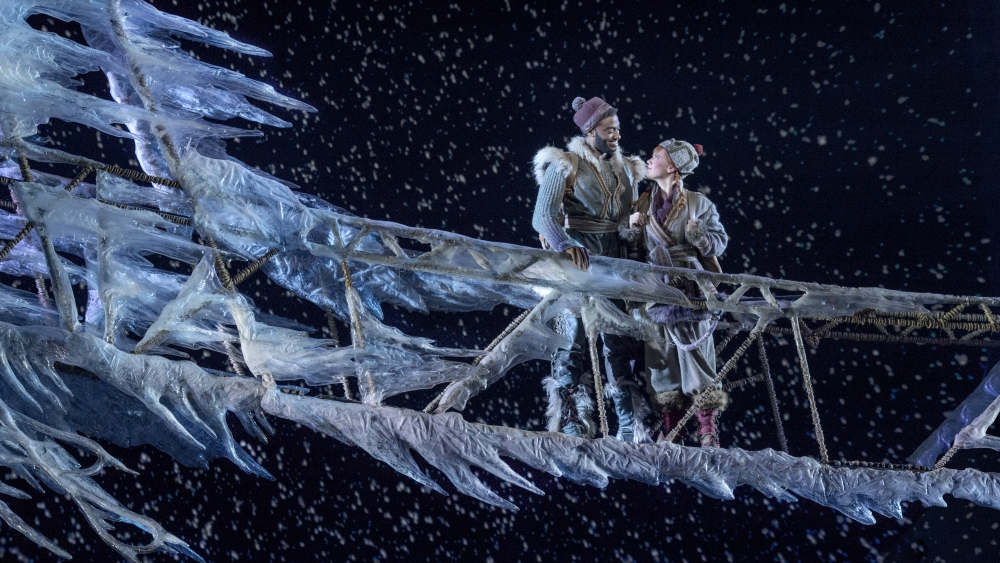Warmth and Humor Pervade Pantages Production of ‘Frozen’ the Musical
By Malina Saval
LOS ANGELES (Variety.com) – In 2013, Disney’s “Frozen” hit screens like a 100 mile-per-hour snowball, sparking a pop cultural phenomenon in which little girls and boys pranced about dressed in Anna and Elsa and Olaf costumes while belting aloud “Let It Go,” Elsa’s feminist anthemic response to ice powers rendering her a societal outcast. The animated movie won two Oscars and netted over $1.2 billion at the worldwide box office. Six years later, its sequel “ 2,” which has earned an Oscar nomination for best original song, bowed in theaters. It’s currently grossed over $1.3 billion globally.
In 2018 “Frozen” also went to Broadway, breathing theatrical life into a story that’s not just about an eternal winter that almost was, but about the enduring power of sisterly love. The stage version has proven itself to be a major success, spawning national tours. This past December, the “Frozen” North American tour (starring Caroline Bowman as Elsa and Caroline Innerbichler as Anna) began a nine-week engagement at Hollywood’s Pantages Theatre, enchanting audiences not only with the songs and story that made the cinematic versions so magical, but with added touches in the way of sparkly costumes, a new original track, good-natured humor targeted at both youngsters and adults, and a sibling relationship between Elsa and Anna that’s even more heartwarming than the one they share onscreen.
“We wanted to create a new energy, because we couldn’t just re-do the movie,” says Michael Grandage, “Frozen’s” Tony Award-winning director and artistic director of the London-based Michael Grandage Company.
“We wanted to create new pieces,” he continues. “And we changed a lot, actually, because we’re trying to reach a live audience of both adults and children every night with live people on stage. And while the source material and starting point for ‘Frozen’ [the movie] is very much a children book’s [‘The Snow Queen’ by Hans Christian Andersen], there’s no escaping the fact that there was a group of adults who were making it.”
The two big-screen versions of “Frozen” are imbued with funny sequences throughout — Olaf’s “In Summer” song, Anna’s clumsiness — but the stage version beefs up these elements even more. For example, Scandinavian nudity gets more play in the theatrical’s version’s “Hygge” number.
“We spend our lives trying to preserve the child in all of us, but we are, nonetheless, adults now and we are creating this show for adults as well as children,” says Grandage. “ I don’t think of it as a group of adults trying to come up with a children’s show. It’s a group of adults trying to creatively, through choreography, through writing songs and set design, trying to come up with something that appeals to everybody universally.”
While the film versions feature an almost all-white cast (albeit animated), the North American tour of “Frozen” features a racially and culturally diverse roster of characters, reflecting the world at large. In fact, the first two characters (after the intro) that appear on stage in “Frozen” are the King and Queen, both of whom are from different ethnic backgrounds. This, notes Grandage, “was a conscious decision.”
“I remember saying to everybody, look, this is the very first relationship in the play, it’s the very first thing we see after the two little children, and if their parents can be a part of a mixed-race marriage straight off of that, then immediately we’re sending out a signal that absolutely says everything,” he says. “It means we’re sending out a very positive message.”
For Grandage, what’s also important about “Frozen” is that it’s likely the first, or one of the first, theater experiences for the younger generation. He wants to make sure it’s an inspiring one.
“The fact that a huge proportion of the audience members are going to be young and impressionable, and that it might even be the very first time they come to the theater,” he says. “That comes with a huge amount of responsibility because what you want is for them to start, if possible, a lifelong relationship with the theater. You want them to go on coming for the rest of their lives. Beyond that, you also realize you’ve got responsibilities surrounding the fact that what [children] see up there on the stage is an extension of the world they live in. You can go, Oh, ‘‘Frozen,’ it’s a cartoon,’ but actually, with ‘Frozen,’ we’ve been given the opportunity to bring animated visuals to life with proper breathing human beings. And to be able to invest in all that the subtleties and nuances that human beings have has one of the most joyful privileges.”
“Frozen” runs through Feb. 2 at in Hollywood.

